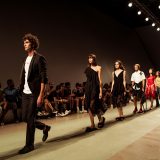The Psychology of Fashion: How Clothing Choices Affect Mood and Behavior

Fashion is far more than the mere threads we use to cover ourselves; it’s a complex language, a powerful psychological tool that significantly shapes our daily experiences. The choices we make in front of the wardrobe each morning are not arbitrary; they are deeply intertwined with our emotions, our cognitive processes, and how we navigate the social world. This exploration delves into the fascinating field of fashion psychology, uncovering how what we wear influences not only how others perceive us but, more profoundly, how we feel and behave.
Understanding enclothed cognition and its effects
At the heart of fashion psychology lies the concept of ‘enclothed cognition,’ a term introduced by researchers Hajo Adam and Adam D. Galinsky in a significant 2012 study. It describes the systematic influence clothing can have on our thoughts and actions. This isn’t merely about the symbolism we attach to clothes, but crucially involves the physical act of wearing them. Their well-known experiment involved lab coats: participants wearing a coat described as belonging to a doctor exhibited heightened attention compared to those wearing the same coat labelled as a painter’s, or those without a coat. This powerfully illustrates how the associations tied to specific garments can activate corresponding mental processes and behaviors, essentially letting us ‘wear’ the perceived qualities of the clothes.
This phenomenon extends far beyond controlled experiments into our everyday realities. Professor Karen Pine, in her book ‘Mind What You Wear,’ compellingly argues that our clothing choices directly influence our mental states. Her research revealed that students wearing a Superman T-shirt not only reported feeling more confident but also perceived themselves as physically stronger, suggesting a tangible link between clothing symbolism and self-perception. Further evidence comes from studies showing a strong majority feel their confidence is tied to their attire; research highlighted by The Bubble found that 96% of women link clothing to confidence. This connection isn’t just emotional; enclothed cognition also suggests that certain attire can subtly boost cognitive performance. Wearing clothes associated with intelligence or focus, like the doctor’s coat, may improve attention to detail, while formal wear might enhance abstract thinking. This affirms clothing as a potent tool for self-modulation, impacting mood, self-esteem, and even cognitive function daily.
Expressing ourselves through style choices
Color psychology is a vital element within fashion, examining how different shades affect emotions and actions. While personal interpretations differ, certain colors often carry shared psychological meanings. Energetic warm colors like red and orange are frequently associated with passion and excitement, potentially increasing assertiveness. In contrast, cool blues and greens are known for their calming properties, fostering relaxation and tranquility – often utilized in professional wear to signal stability. Yellow typically evokes happiness, black suggests sophistication and power, and white often represents purity. Understanding these common associations enables us to strategically use color to influence our own mood or project a desired image. This is actively employed in ‘dopamine dressing,’ which encourages choosing clothes—perhaps a specific vibrant color or a pleasing texture—based on their ability to personally trigger joy and uplift the wearer’s spirits.
Beyond color, the balance between comfort and style profoundly impacts psychological well-being. Fashion trends might entice us with restrictive or physically awkward garments, but sacrificing comfort can lead to irritability, distraction, and reduced confidence. On the other hand, focusing solely on comfort might leave one feeling less self-assured in certain contexts. Finding a harmonious blend is crucial. The popularity of ‘athleisure’ reflects this widespread desire for clothing that merges aesthetic appeal with physical ease. Ultimately, selecting garments that feel good on the body while aligning with one’s personal style fosters authentic self-expression and bolsters inner confidence. This equilibrium is deeply individual, requiring awareness of personal needs and preferences.
Clothing serves as a primary vehicle for self-expression and identity construction. Our fashion choices communicate volumes about our personality, values, group affiliations, and aspirations, often before a word is spoken. As fashion psychologist Shakaila Forbes-Bell explains, the link between clothing, validation, and self-image is strong; standing out through style can enhance how we see ourselves and how others interact with us. From minimalist aesthetics signalling certain values to bold subcultural styles or traditional attire worn during cultural events, clothing functions as a visual biography. It allows us to signal belonging, assert individuality, or adopt different personas. Psychologist Dr. Jennifer Baumgartner notes that we often dress to project a specific version of ourselves. This includes ‘power dressing’—for instance, wearing a sharply tailored suit for an important presentation to convey authority and competence. This non-verbal communication is a continuous dialogue between our internal sense of self and the external social world.
The narrative around fashion is also shaped by external forces, particularly media and advertising. These platforms often promote narrow and unrealistic beauty standards, which, as highlighted in sources like Vocal Media and FasterCapital, can negatively impact body image and self-esteem, linking clothing choices to feelings of inadequacy or dissatisfaction. Recognizing this influence is crucial for fostering a healthier relationship with fashion. Concurrently, fashion choices can be influenced by nostalgia. As discussed in fashion psychology analyses, clothing from past eras or vintage styles can evoke powerful memories and feelings of comfort or warmth, impacting current preferences and contributing another layer to our emotional connection with what we wear.
Fashion psychology in daily life
Often overlooked, accessories carry significant psychological weight. They provide nuanced avenues for self-expression, allowing personalization and communication of subtle personality aspects or moods. A bold necklace, a vibrant scarf, or meaningful jewellery can instantly transform an outfit and enhance the wearer’s confidence. Accessories can also hold sentimental value, triggering memories and emotions, adding depth to the psychological impact of getting dressed. Furthermore, accessories and self-esteem are often linked, with research suggesting those who utilize them may report higher levels of self-assurance. They act as finishing touches that complete a visual narrative, reinforcing the intended message and sense of self.
Our relationship with clothing also involves psychological attachments and habits. Seemingly superstitious practices, like having ‘lucky’ clothes, tap into this. The belief that a specific item brings good fortune can function as a placebo, boosting confidence and potentially enhancing performance by reducing anxiety and increasing self-belief. This highlights our innate tendency to imbue garments with meaning. Another habit is the ‘Repetitious Wardrobe Complex,’ where individuals repeatedly purchase similar items. As noted in discussions on the brain science behind retail, this often stems from a desire for comfort and risk aversion, as familiar choices offer comfort and feel safe. While potentially limiting style exploration, it underscores the fundamental need for security that clothing choices can fulfill.
Fashion operates powerfully within social perception. Our clothing choices significantly shape first impressions, influencing assumptions about our personality, status, and competence. Understanding this allows for strategic use of clothing to navigate social and professional environments more effectively. However, external pressures regarding attire can sometimes trigger resistance. Insights from The Conversation highlight how prescriptive messaging can backfire due to psychological reactance – our tendency to resist perceived threats to our freedom. Even well-intentioned advice, if perceived as overly controlling, can lead individuals to reject it. This underscores the importance of authenticity in personal style choices.
Weaving well-being through wardrobe choices
The daily act of dressing can be reframed as a potent form of self-care, contributing positively to emotional well-being. Consciously selecting an outfit that evokes good feelings is an act of self-compassion, prioritizing personal comfort and confidence. This mindful approach can elevate mood, bolster self-esteem, and encourage a more positive body image. Clinical psychologist Dr. Susan Albers points out that clothing can be either a tool for self-love or self-criticism. By choosing garments that celebrate our bodies and align with our authentic selves, we tap into fashion’s potential to support mental health. This concept is supported by qualitative research, such as the ‘Flourishing Fashion’ study, which demonstrated how participants intentionally used ‘happy outfits’ to manage identity, regulate mood, build resilience, and foster social connections, aligning with positive psychology principles.
Cultivating a personal style that genuinely mirrors one’s inner self is a rewarding journey that significantly enhances well-being. It requires looking beyond transient trends to grasp what truly resonates personally – considering values, lifestyle, and aesthetic inclinations. Celebrity stylist Aimee Croysdill aptly describes personal style as a ‘blueprint’ or ‘identity,’ functioning as ‘body armor’ that fosters confidence. Achieving this synergy between internal self and external presentation generates a sense of coherence and authenticity. Organizations like House of Colour base their services on this very principle, employing color science and style analysis to assist individuals in building empowering wardrobes. The goal isn’t conformity but the curation of a visual language that feels uniquely personal.
Conclusion The threads that bind us
Ultimately, the psychology of fashion illuminates a profound connection: clothing is deeply interwoven with our internal world. It represents a dynamic interplay between self-perception, emotional regulation, cognitive processes, and social interaction. As Dr. Karen Pine powerfully states, clothing changes self-perception, influencing not just how others view us, but how we experience ourselves. By grasping the principles of enclothed cognition, color psychology, and the significance of personal style, we can consciously wield fashion as a tool. It empowers us to navigate life with enhanced confidence, express our true selves more vividly, and cultivate a richer sense of well-being. Fashion, at its core, provides a tangible means to shape our experience, transforming the routine act of getting dressed into an ongoing opportunity for self-discovery and empowerment.

